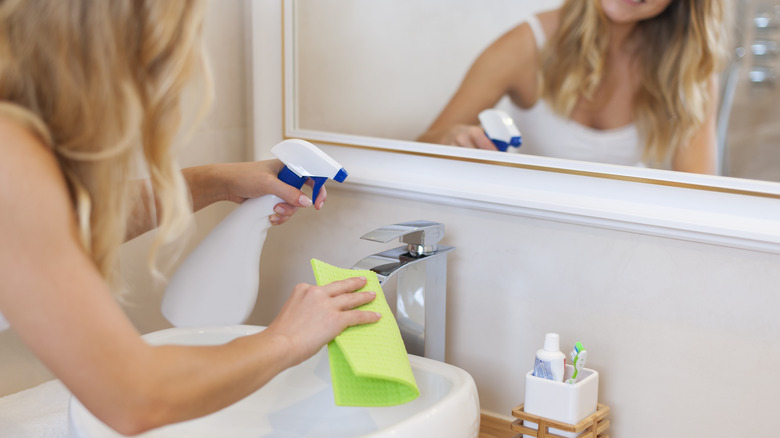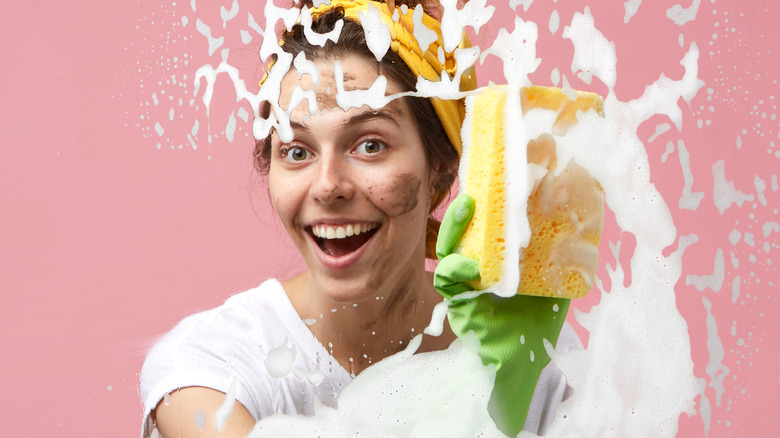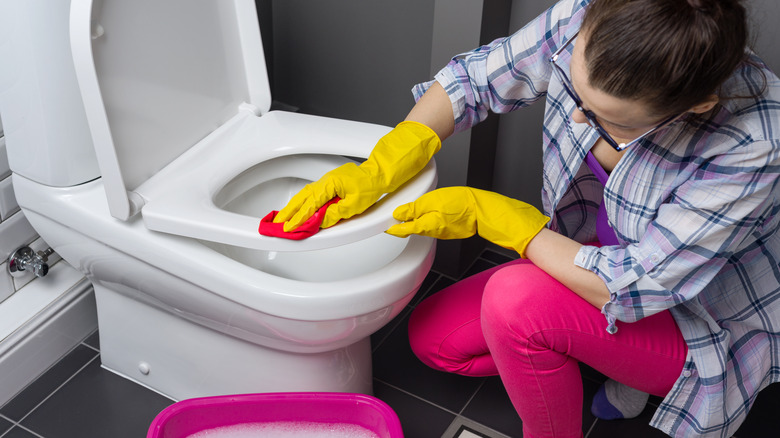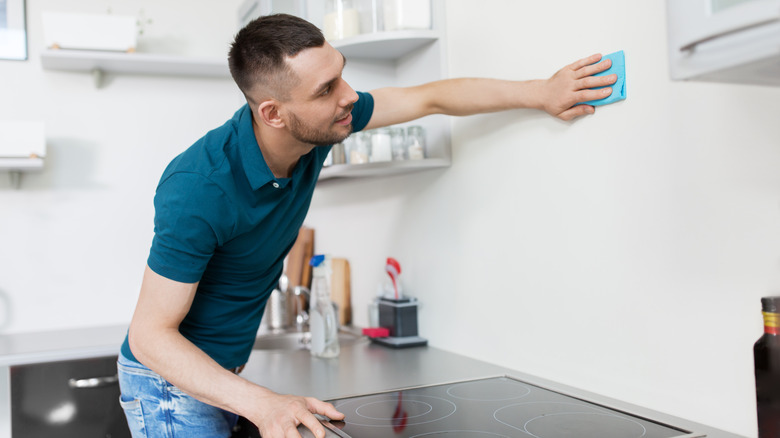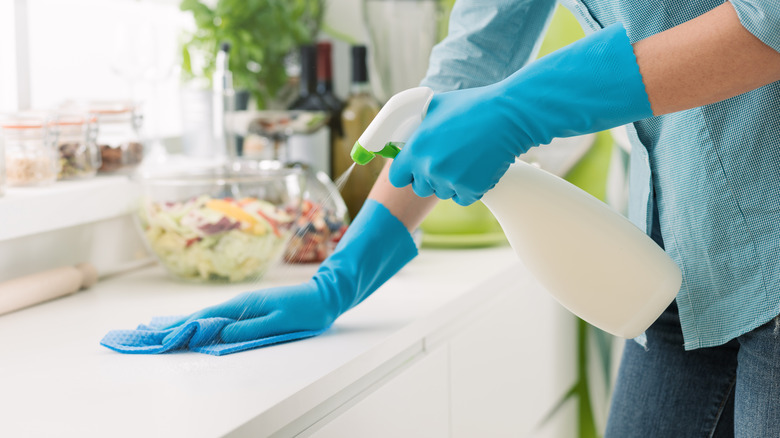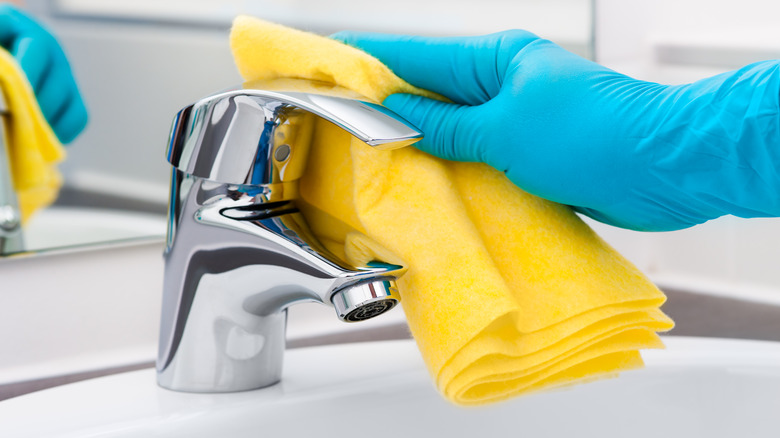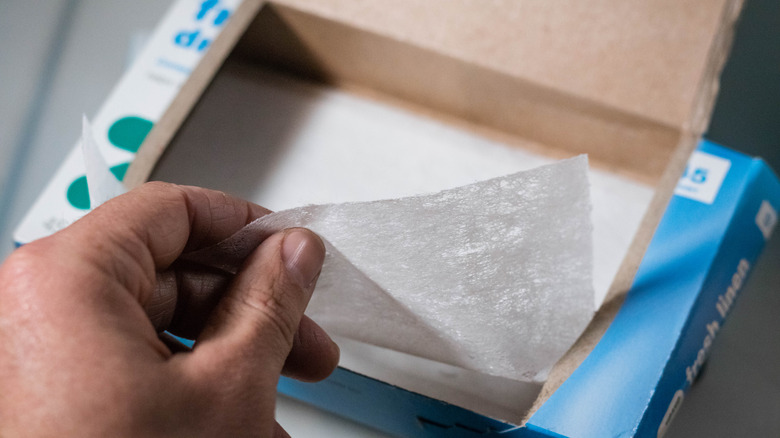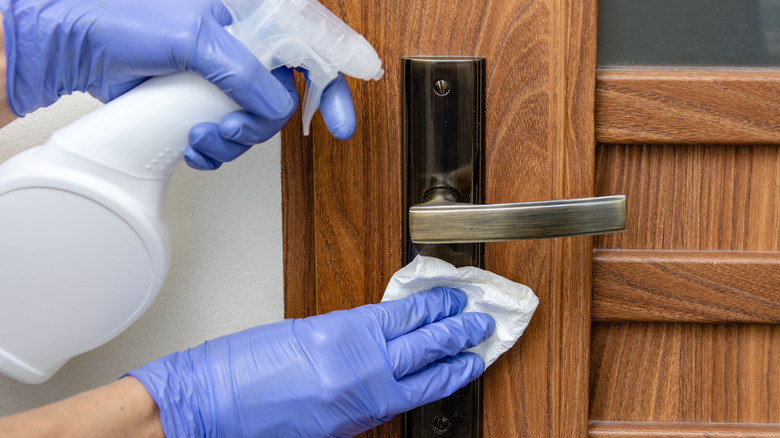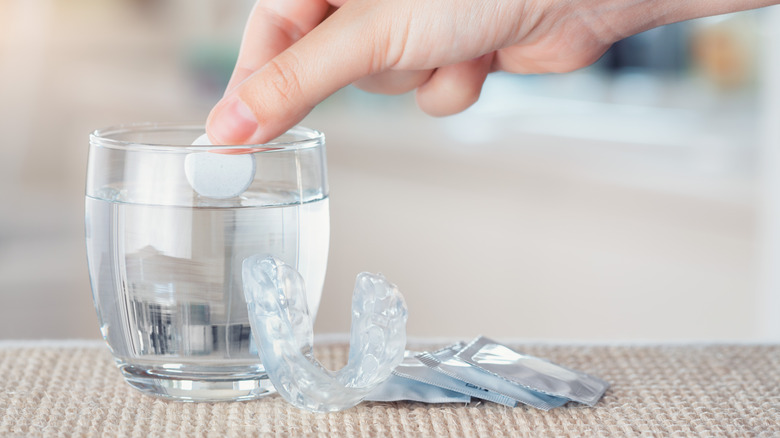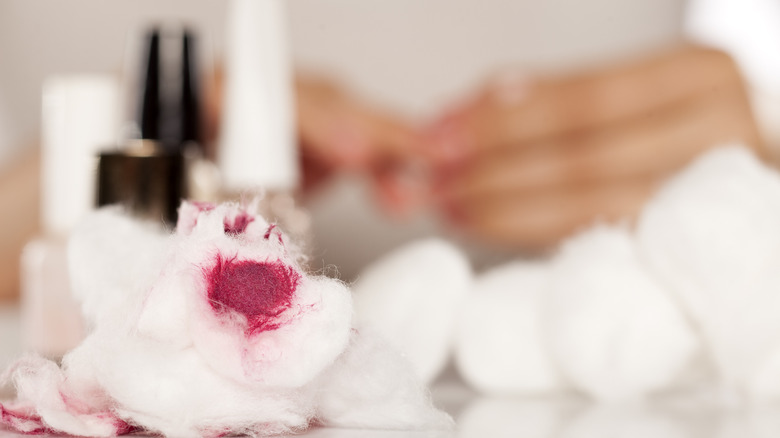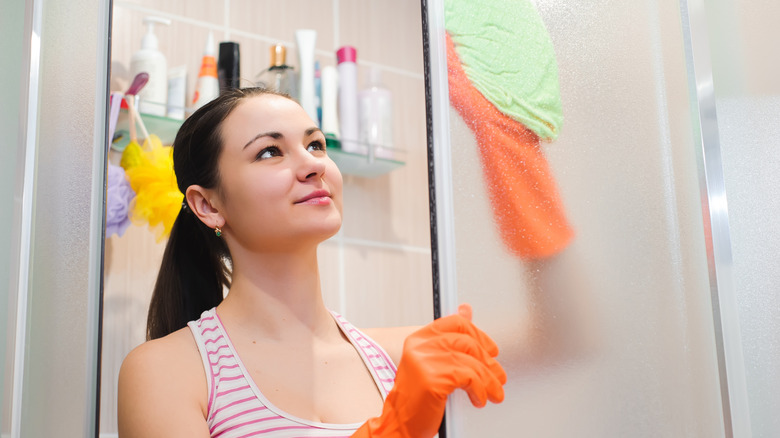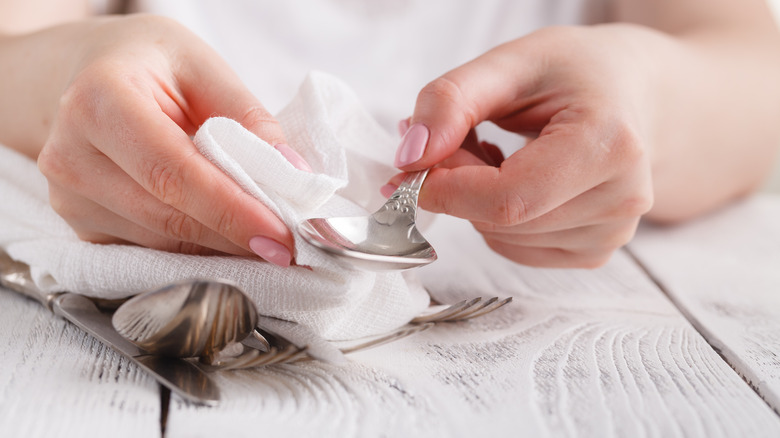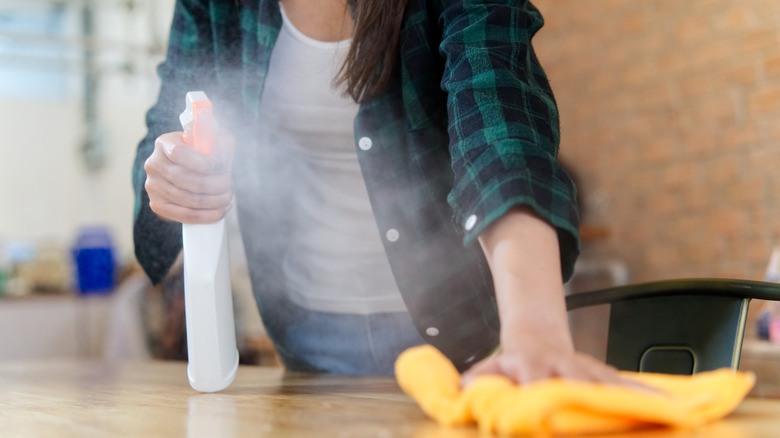12 Cleaning Ingredients That You Might Not Know Are Hiding In Your Bathroom
Did you know that when you clean, you might have several great cleaning products in your bathroom that don't necessarily have to just be for the bathroom? While your bathroom is a spot for personal hygiene, it has many powerful cleaning agents you may not think twice about. Things like toothpaste, shampoo, and mouthwash can all double as effective cleaning agents for the whole house instead of being restricted to personal care use.
Bathroom staples can transform your cleaning routine. For example, shampoo does a lot more than clean your hair; it also takes on soap scum on your tiles and shower doors. Toothpaste polishes metal fixtures to make them shine and removes scuffs from shoes. Mouthwash's antiseptic properties make it a powerful disinfectant for various surfaces.
Understanding what these products are and what they can do to help you clean underscores the importance of looking at things through a new lens. The multifunctional nature of these supplies can reduce waste, save time, and give you a sustainable approach to your home maintenance routine. It's an unexpected discovery that makes you rethink how you view the things on your bathroom shelves as you fight dirt and grime.
Shaving cream cleans mirrors and glass
Shaving cream works as a solid cleaning solution for glass and mirrors. The creamy, thick texture sticks well to vertical surfaces, making it an excellent option for glass fixtures or any mirrors in your home. To use it, add a small amount onto the surface or a dry, clean cloth. Spread it evenly over the surface, ensuring you cover everything. Leave it alone for five minutes to give it time to break down oils, dirt, and soap scum. Wipe it off using a damp, clean cloth and then with a dry cloth to avoid streaking and get a sparkling shine.
Before you coat the whole mirror or glass surface with shaving cream, do a spot test in a small corner. When you wipe it off, ensure the shaving cream doesn't leave any residue or finish damage.
Using shaving cream over traditional glass cleaner prevents fog from building up on the surface. Shaving cream has cleaning agents and surfactants in its makeup, and this allows it to break down dirt and lift away residues and oils, including soap scum. The surfactants lower the surface tension between the glass and dirt, letting you wipe them away. The anti-fog properties work by creating a protective, thin layer over the surface, and this stops water molecules from condensing into a fog, keeping your mirrors clear.
Pumice stones remove lime and rust stains
Though commonly used to smooth skin, a pumice stone can also be used to clean the toilet, sink, or bathtub, stripping away lime and rust stains. Its natural abrasive qualities allow you to scrub away buildup, especially in areas with hard water. To clean, get the stone and whatever surface you're going to clean wet and gently rub the pumice stone over the stains using a circular motion, applying steady but light pressure.
You may have to take several passes at whatever you're cleaning for it to be effective, but the abrasive surface will gradually wear the stain away. Also, always wet the pumice stone and whatever you're cleaning before scrubbing to reduce the risk of scratching.
Pumice stones work to remove lime and rust stains from surfaces due to their volcanic origin, which lends an abrasive, porous texture. This texture allows you to gently scour the surface without using harsh chemicals, creating a softer abrasion to reduce the risk of damage. As you scrub, it physically breaks down the limescale and rust particles, making them easy to rinse. It works well in areas with hard water because mineral deposits are more prone to building up and more challenging to remove.
Bar soap cleans non-porous surfaces and fills holes
Bar soap is an effective household cleaner for repairing minor holes. In solid form, you can use it as a potent cleaning solution for non-porous surfaces like walls and floors. Grate a bar of soap into fine shavings and mix them with warm water until they dissolve. Use a mop or cloth to apply this mixture to whatever surface you clean to lift dirt and grime. Bar soap also helps fill small holes. To hide pesky wall holes with bar soap, rub the dry soap directly over the hole using a circular motion until it fills it.
You must use warm or hot water and take the time to dissolve the soap before you use it to clean thoroughly. If you don't, the soap could leave a slippery residue on your floor that could be a hazard. Also, to use it for filling holes, this is a temporary solution instead of a permanent one, but it works in a pinch to fill holes before painting them.
Bar soap is effective at cleaning due to its surfactant properties. It reduces the surface tension between dirt and water, making lifting and removing them from non-porous surfaces easy. When dissolved, bar soap releases surfactants, making it a great way to tackle dirty floors and walls without chemicals. The gentle composition allows you to clean without damage.
Mouthwash disinfects surfaces around the house
Mouthwash can be a potent disinfectant agent for household surfaces because its alcohol content has antimicrobial and antiseptic properties. Brands with alcohol do work better for cleaning, and all you do is mix a 1:1 ratio of mouthwash and water, fill a spray bottle, and spritz it directly onto whichever surfaces you want to clean. Spray it on countertops, bathroom fixtures, and kitchen tables. Once you spray, wipe down the surfaces with a clean cloth to remove bacteria and dirt. The minty scent it leaves acts like a deodorizer, and it's a quick and efficient way to disinfect.
It's essential that you reach for light-colored or clear mouthwash for cleaning instead of the brightly dyed options. This is because the dye in those mouthwashes can stain whatever you spray it on, especially porous surfaces.
Mouthwash works as a household disinfectant because of its antiseptic components. Alcohol can kill viruses and bacteria on contact by breaking down cell walls. So, alcohol-containing mouthwashes are an effective and convenient way to sanitize surfaces, fight bacteria, and reduce germ spread. Alcohol also has a quick-drying nature that stops water spots from forming or streaking, leaving clean surfaces.
Baby oil polishes chrome fixtures and removes soap scum
While most people use this product for skin care, baby oil can remove soap scum from the shower and polish chrome fixtures. The mineral-based, light makeup is excellent for helping you get a sparkle without leaving spots or streaks. Apply a small amount of baby oil to a soft, lint-free cloth and rub it gently over the chrome fixtures, shower doors, and faucets to remove soap scum and make the metal shine. The oil cleans and polishes the surface, leaving a gleaming, smooth finish. Buff the surface with a dry cloth to remove any residue.
However, while baby oil works well, it's vital that you understand a little goes a long way. Use it sparingly and buff the surface to ensure it doesn't leave a slippery residue. Depending on the surface, this could be a safety hazard.
The mineral oil base in baby oil is the key to how effective it is at polishing chrome and stripping soap scum. Mineral oil is unique because it creates a protective barrier on surfaces that helps repel water and reduce the chances of smudging or water spots forming. Also, baby oil's slick nature helps remove soap scum without resorting to abrasive cleaners that can damage the finish. The oil fills microscopic scratches and imperfections, reflecting light more uniformly and enhancing your fixtures' shine and appearance. The protective layer also helps the metal last longer and withstand tarnishing and corrosion.
Dryer sheets remove dust and polish surfaces
Dryer sheets reduce static cling and soften clothing, but you can repurpose laundry dryer sheets to help you dust and polish various surfaces around the house. The antistatic properties make them excellent for attracting and holding dust, pet hair, and other tiny particles to clean surfaces more efficiently. To dust with dryer sheets, take a used sheet and wipe down fixtures, mirrors, and furniture. They work well on less porous surfaces because they'll also help polish and buff to give you a streak-free shine and a pleasant scent.
Be aware that dryer sheets don't work well on heavily soiled surfaces, and you want to use them carefully because older sheets can leave an unpleasant residue. If it does, you'll have to go back over whatever you just wiped down with a damp cloth.
Dryer sheets are so effective at polishing and dusting due to their antistatic properties and softening agents. They are designed to reduce static and soften clothes as you dry them, making them excellent at trapping dust particles. When you pass them over surfaces, they leave a very light film that repels future dust. The soft texture is also gentle on surfaces, reducing the risk of scratching while removing hair and dust. The lubricants in the dryer sheets create a shiny, smooth surface on fixtures and mirrors, too.
Hydrogen peroxide disinfects surfaces
Hydrogen peroxide is a powerful and versatile cleaning agent that can disinfect surfaces. You can use it outside medical settings to sanitize personal care items and surfaces. Dilute the peroxide in water to create a 3% solution, as this will be safe for most surfaces, and apply it directly to whatever you want to disinfect. For dirt and grime in the bathroom or kitchen, give the mixture a few minutes to work before you wipe it clean. It brightens grout and sanitizes cutting boards, toothbrushes, and non-porous items. It'll give you a thorough clean without leaving a sticky residue or streaks.
If you use peroxide to clean colored surfaces or fabrics, be very careful. This mixture does have bleaching agents that can fade the color, so test it on a small area before you spray the whole piece of fabric or surface.
Hydrogen peroxide is a disinfectant because it releases oxygen when it comes into contact with viruses, bacteria, or other organic matter. This is oxidation, and it disrupts the walls of microbial cells, destroying them. The bubbling action is proof of this reaction, and it helps to lift dirt and debris so you can wipe them away. It's good at killing mildew and mold, making it a great bathroom cleaner. The mild bleaching effect lets you lighten and brighten grout stains without using bleach.
Denture tablets remove stains from porcelain and grout
Denture tablets are an excellent way to remove stains from grout and porcelain. Dissolve the recommended number of tablets in water, following the package's directions. For toilets, drop a few tablets right into the bowl and let them dissolve before you scrub it with a toilet brush. To clean sinks and grout, fill the basin with enough water to cover the stained spot and add the tables. Another option is to apply the dissolved solution to the grout lines. The fizzing action helps break down stains so you can scrub them away. If you want to use them on a bigger area, like to clean a tile and grout floor, you can fill a bucket with the solution and scrub with a stiff-bristled brush.
However, make a point to follow whatever the directions on the packaging say regarding how many tables you should use and how long you should let them soak. Doing so reduces the risks of damaging any surfaces you want to clean, especially grout or porcelain.
The chemical makeup of denture tablets, especially the citric acid and sodium bicarbonate, makes them powerful cleaners. When they dissolve, they undergo a chemical reaction that releases a host of oxygen bubbles. The bubbles loosen dirt, lift stains, and stop microbial growth, making them easier to clean. The bubbles get into porous structures to remove set-in stains and sanitize whatever you're cleaning.
Nail polish remover removes stains
Acetone-based nail polish can be a powerful cleaning tool that removes tough porcelain and tile stains, including nail polish. It has strong solvent properties that help it remove nail polish spills, ink stains, and adhesive residues. Apply a small amount to a soft cloth or cotton ball and gently rub or dab the stain. The nail polish remover will start to break down the stain so you can wipe it away. For sticky residue, give it 10 to 15 minutes to work before scrubbing it with a cloth or non-abrasive pad.
Ensure you have a well-ventilated space to use it before you open it because it can have a powerful smell. Also, do a patch test on a hidden spot on whatever you want to clean to avoid damaging the plastics or finishes.
The chemical properties of acetone-based nail polish remover make it great at removing stains. Acetone is a strong solvent that dissolves organic compounds, including what you find in stains. Its molecular structure lets it break the stain's bonds and lift them from the surface of whatever they adhere to. It's particularly effective for oil, paint, grease, or stains water-based cleaners don't work on. The fast evaporation rate also means it leaves less residue, reducing the risk of damage or more staining.
Shampoo removes soap scum
Shampoo helps clean shower walls, glass doors, and bathtubs because it is formulated to remove dirt and grease on hair. So, it works on body oil residue and soap scum, and it has a gentle makeup that allows you to use it on delicate surfaces without damaging them. Apply a small amount of shampoo to a cloth or damp sponge and gently scrub at the surface, rinsing when you finish. It also has a fresh scent to leave your bathroom smelling fresh. However, be aware that shampoo may not work well against hard water stains and won't disinfect whatever you want to clean with it.
The key to shampoo's effectiveness in cleaning surfaces lies in its surfactants. These compounds attract water and oil, allowing them to lift grease, body oils, and dirt from the hair and scalp. When applied to bathroom surfaces, the same principle applies; the surfactants in shampoo bind to the soap scum and body oils on the surface, making them easy to rinse away. This action cleans and helps to prevent the accumulation of residue. This makes shampoo an excellent option for those looking for a mild yet effective cleaning solution for their bathroom.
Toothpaste removes scuffs from shoes and polishes silver
Toothpaste plays a vital role in keeping your teeth and gums healthy, but it can also work to remove scuffs from your shoes and polish silver. This gives you an accessible and cost-effective solution to fix these common issues. Apply the small amount with a damp, soft cloth. To use this bathroom product to polish your silver, rub it in a circular motion over any tarnished spots, rinse it with water, and dry it using a soft cloth. Apply the toothpaste directly to the marks for shoe scuffs and rub gently using a soft cloth or a soft-bristled toothbrush before wiping them clean with a damp cloth.
However, it's critical that you don't use gel-based or whitening toothpaste to polish silver or try to get scuffs out of your shoes. These toothpaste types have harsher ingredients and can damage the surfaces instead of removing the marks or tarnish.
Toothpaste removes scuffs and tarnish because it's a mild abrasive. It's gentle enough to lift and remove minor stains, scratches, or tarnishes without damaging whatever surface you're cleaning. The abrasives gently scrub the surface to reduce how visible imperfections are as you scrub. Also, how convenient this is for cleaning plays a role as it's a staple in most households that is readily available for quick work.
Rubbing alcohol disinfects surfaces
Rubbing alcohol is very effective in helping you sanitize and clean your household surfaces, like faucets, countertops, and personal items like toothbrushes. It works fast to kill bacteria and germs and remove water spots. Apply the rubbing alcohol directly to the surface to remove stains, grime, and dirt. For toothbrushes or other personal care items, quickly dip them into the rubbing alcohol or spray them to sanitize them. It evaporates quickly without leaving a residue, so it's convenient for a fast cleanup.
When you use rubbing alcohol, ensure that your cleaning area has good ventilation so fumes don't build up. Also, take precautions to ensure it doesn't get into your eyes or you don't breathe it in, as this can cause irritation. Additionally, it's best to use this as part of a sanitizing routine because the National Institutes of Health found it to be 36.7% effective at killing bacteria.
The high concentration of isopropyl alcohol in rubbing alcohol makes it moderately successful at disinfecting because it has germicidal properties. It gets into the bacteria and virus-cell walls and kills them on contact. The fast evaporation also gives you a streak-free finish and minimizes how long your cleaned surfaces stay wet, reducing the risk of bacteria growth. It can also absorb oils and water-insoluble substances, so it can help remove stains.
